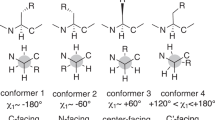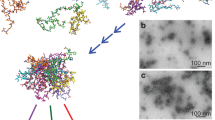Abstract
Amyloids are a class of noncrystalline, yet ordered, protein aggregates. A new approach was used to provide the initial structural data on an amyloid fibril—comprising a peptide (β34–42) from the C-terminus of the β-amyloid protein—based on measurement of intramolecular 13C–13C distances and 13C chemical shifts by solid-state 13C NMR and individual amide absorption frequencies by isotope-edited infrared spectroscopy. Intermolecular orientation and alignment within the amyloid sheet was determined by fitting models to observed intermolecular 13C–13C couplings. Although the structural model we present is defined to relatively low resolution, it nevertheless shows a pleated antiparallel β-sheet characterized by a specific intermolecular alignment.
This is a preview of subscription content, access via your institution
Access options
Subscribe to this journal
Receive 12 print issues and online access
$189.00 per year
only $15.75 per issue
Buy this article
- Purchase on Springer Link
- Instant access to full article PDF
Prices may be subject to local taxes which are calculated during checkout
Similar content being viewed by others
References
Sipe, J.D. Amyloidosis. A. Rev. Biochem. 61, 947–76 (1992).
Glenner, G.G. Amyloid deposits and amyloidosis: The β-fibrilloses (first of two parts). New. Engl. J. Med. 302, 1283–1292 (1980).
Glenner, G.G. Amyloid deposits and amyloidosis: The β-Fibrilloses (second of two parts). New. Engl. J. Med. 302, 1333–1343 (1980).
Cohen, A.S. & Skinner, M. New frontiers in the study of amyloidosis. New Engl. J. Med. 323, 542 (1990).
Lansbury, P.T., Jr. In pursuit of the molecular structure of amyloid plaque: New technology provides unexpected and critical information. Biochemistry 31, 6865–6870 (1992).
Jarrett, J.T. & Lansbury, P.T., Jr. Seeding the “one-dimensional crystallization” of amyloid: A pathogenic mechanism in Alzheimer's disease and Scrapie? Cell 73, 1055–1058 (1993).
Lotz, B., Gonthier-Vassal, A., Brack, A. & Magoshi, J. Twisted single crystals of Bombyx mori silk fibroin and related model polypeptides with β structure. J. molec. Biol. 156, 345–357 (1982).
Marsh, R.E., Corey, R.B. & Pauling, L. An investigation of the structure of silk fibroin. Biochim. biophys. Acta 16, 1–34 (1955).
Kosik, K.S. Alzheimer's disease: A cell biological perspective. Science 256, 780–783 (1992).
Kosik, K.S., Alzheimer's disease sphinx: A riddle with plaques and tangles. J. cell Biol. 127, 1501–1514 (1994).
Yankner, B.A. & Mesulam, M.-M. β-amyloid and the pathogenesis of Alzheimer's disease. New Eng. J. Med. 325, 1849–1857 (1991).
Selkoe, D. The molecular pathology of Alzheimer′s disease. Neuron 6, 487–498 (1991).
Seubert, P. et al Isolation and quantification of soluble Alzheimer′s β-peptide from biological fluids. Nature 359, 325–327 (1992).
Shoji, M. et al. Production of the Alzheimer amyloid β protein by normal proteolytic processing. Science 258, 126–129 (1992).
Haass, C. et al. Amyloid β-peptide is produced by cultured cells during normal metabolism. Nature 359, 322–325 (1992).
Iwatsubo, T. et al. Visualization of Aβ42(43) and Aβ40 in senile plaques with end-specific Aβ monoclonals: Evidence that an initially deposited species is Aβ42(43). Neuron 13, 45–53 (1994).
Jarrett, J.T., Berger, E.P. & Lansbury, P.T., Jr. The carboxy terminus of β amyloid protein is critical for the seeding of amyloid formation: implications for the pathogenesis of Alzheimer's disease. Biochemistry 32, 4693–4697 (1993).
Cai, X.-D., Golde, T.E. & Younkin, S.G. Release of excess amyloid β protein from a mutant amyloid protein precursor. Science 259, 514–516 (1993).
Suzuki, N. et al. An increased percentage of long amyloid β protein secreted by familial amyloid β protein precursor (βAPP717) mutants. Science 264, 1336–1340 (1994).
Tamaoka, A. et al. App717 Missense mutation affects the ratio of amyloid β protein species (Aβ1-42/43 and Aβ1-40) in familial Alzheimer's disease brain. J. biol. Chem. 269, 32721–32724 (1994).
Halverson, K., Fraser, P.E., Kirschner, D.A. & Lansbury, P.T. Jr. Molecular determinants of amyloid deposition in Alzheimer's disease: conformational studies of synthetic β-protein fragments. Biochemistry 29, 2639–2644 (1990).
Ashburn, T.T., Auger, M. & Lansbury, P.T., Jr. The structural basis of pancreatic amyloid formation: Isotope-edited spectroscopy in the solid state. J. Am. chem. Soc. 114, 790–791 (1992).
Halverson, K.H., Sucholeiki, I., Ashburn, T.T. & Lansbury, P.T., Jr. Location of β-sheet-forming sequences in amyloid proteins by FTIR. J. Am. chem. Soc. 113, 6701–6703 (1991).
Krimm, S. & Bandekar, J. Advances in protein chemistry (ed C. Anfinsen) 183–364 (Academic Press, Boston, 1986).
Saitô, H. Conformation-dependent 13C chemical shifts: a new means of conformational characterization as obtained by high-resolution solid-state 13C NMR. Magn. reson. Chem. 24, 835–852 (1986).
Spera, S. & Bax, A. Empirical correlation between protein backbone conformation and Cα and Cβ 13C nuclear magnetic resonance chemical shifts. J. Am. chem. Soc. 113, 5490–5492 (1991).
de Dios, A.C., Pearson, J.G. & Oldfield, E. Secondary and tertiary structural effects on protein NMR chemical shifts: An ab initio approach. Science 260, 1491–1496 (1993).
Griffiths, J.M. & Griffin, R.G. Nuclear magnetic resonance methods for measuring dipolar couplings in rotating solids. Analytica chim. Acta 283, 1081–1101 (1993).
Spencer, R.G.S., Halverson, K.J., Auger, M., McDermott, A.E;., Griffin, G.R. & Lansbury, P.T., Jr. An unusual peptide conformation may precipitate amyloid formation in Alzheimer's disease: Application of solid-state NMR to the determination of protein secondary structure. Biochemistry 30, 10382–10387 (1991).
Raleigh, D.P., Creuzet, F., Das Gupta, S.K., Levitt, M.H. & Griffin, R.G. Measurement of internuclear distances in polycrystalline solids: Rotationally enhanced transfer of nuclear spin magnetization. J. Am. chem. Soc. 111, 4502–4503 (1989).
Creuzet, F. et al. Determination of membrane protein structure by rotational resonance NMR: Bacteriorhodopsin. Science 251, 783–786 (1991).
Gu, Z. & McDermott, A. Chemical shielding anisotropy of protonated and deprotonated carboxylates in amino acids. J. Am. chem. Soc. 115, 4282–4285 (1993).
Griffiths, J. et al. Rotational resonance solid-state NMR elucidates a structural model of pancreatic amyloid. J. Am. chem. Soc. 117, 3539–3546 (1995).
Levitt, M.H., Raleigh, D.P., Creuzet, F. & Griffin, R.G. Theory and simulations of homonuclear spin pair systems in rotating solids. J. chem. Phys. 92, 6347–6364 (1990).
VanderHart, D.L., Earl, W.L. & Garroway, A.N. Resolution in 13C NMR of organic solids using high-power proton decoupling and magic-angle sample spinning. J. magn. Reson. 44, 361–401 (1981).
VanderHart, D.L. Influence of molecular packing on solid-state 13C chemical shifts: The n-alkanes. J magn. Reson. 44, 117–125 (1981).
Kennedy, S.D. & Bryant, R.G. Structural effects of hydration: studies of lysozyme by 13C solids NMR. Biopolymers 29, 1801–1806 (1990).
Gregory, R.B., Gangoda, M., Gilpin, R.K. & Su, W. The influence of hydration on the conformation of lysozyme studied by solid-state 13C-NMR spectroscopy. Biopolymers 33, 513–519 (1993).
Harbison, G.S., Herzfeld, J. & Griffin, R.G. Solid state 15N NMR study of the Schiff base in bacteriorhodopsin. Biochemistry 22, 1–5 (1983).
Ishida, M., Asakura, T., Yokoi, M. & Saito, H. Solvent- and mechanical-treatment-induced conformational transition of silk fibroins studied by high-resolution solid-state 13C NMR spectroscopy. Macromolecules 23, 88–94 (1990).
Stewart, D.E., Sarkar, A. & Wampler, J.E. Occurrence and role of Cis peptide bonds in protein structures. J. molec. Biol. 214, 253–260 (1990).
Chou, K.-C. & Scheraga, H.A. Origin of the right-handed twist of β-sheets of poly(LVal) chains. Proc. natn. Acad. Sci. U.S.A. 79, 7047–7051 (1982).
Chou, K.-C., Pottle, M., Nemethy, G., Ueda, Y. & Scheraga, H.A. Structure of β-Sheets. Origin of the right-handed twist and of the increased stability of antiparallel over parallel sheets. J. molec. Biol. 162, 89–112 (1982).
Chothia, C. Conformation of twisted β pleated sheets in proteins. J. molec. Biol. 75, 295–302 (1973).
Salemme, F.R. Structural properties of protein β sheets. Prog. Biophys. molec. Biol. 42, 95–133 (1983).
Baumann, U., Wu, S., Flaherty, K.M. & McKay, D.B. Three-dimensional structure of the alkaline protease of Pseudomonas aeruginosa: a two-domain protein with a calcium binding parallel beta roll motif. EMBO J. 12, 3357–3364 (1993).
Steinbacher, S. et al. Crystal structure of P22 tailspike protein: Interdigitated subunits in a thermostable trimer. Science 265, 383–386 (1994).
Sprang, S.R. On a (β-) roll. Trends biochem. Sci. 18, 313–314 (1993).
Yoder, M.D., Keen, N.T. & Jurnak, F. New domain motif: The structure of pectate lyase C, a secreted plant virulence factor. Science 260, 1503–1507 (1993).
Jurnak, F., Yoder, M.D., Pickersgill, R. & Jenkins, J. Parallel β-domains: a new fold in protein structures. Curr. Opin. struct. Biol. 4, 802–806 (1994).
Lifson, S. & Sander, C. Specific recognition in the tertiary structure of β-sheets of proteins. J. molec. Biol. 139, 627–639 (1980).
von Heijne, G. & Blomberg, C. The β structure: Inter-strand correlations. J. molec. Biol. 117, 821–824 (1977).
Bromberg, S. & Dill, K.A. Side-chain entropy and packing in proteins. Prot. Sci. 3, 997–1009 (1994).
Dill, K.A. Dominant forces in protein folding. Biochemistry 29, 7133–7155 (1990).
Chan, H.S. & Dill, K.A. The protein folding problem. Physics Today, 24–32 (1993).
Cohen, F.E. & Kuntz, I.D. in Prediction of protein structure and the principles of protein conformation (ed G.D. Fasman) 647–706, ch. 17 (New York: Plenum, New York, 1989).
Jarrett, J.T., Costa, P.R., Griffin, R.G. & Lansbury, P.T. Models of the C-terminus: Differences in amyloid structure may lead to segregation of “long” and “short” fibrils. J. Am. chem. Soc. 116, 9741–9742 (1994).
Brooks, B.R. et al. CHARMM: A program for macromolecular energy, minimization, and dynamics calculations. J. comput. Chem. 4, 187–217 (1983).
Howarth, O.W. & Lilley, D.M. Carbon-13 NMR of peptides and proteins. Prog. nucl. magn. reson. Spectrosc. 12, 1–40 (1978).
Author information
Authors and Affiliations
Rights and permissions
About this article
Cite this article
Lansbury, P., Costa, P., Griffiths, J. et al. Structural model for the β-amyloid fibril based on interstrand alignment of an antiparallel-sheet comprising a C-terminal peptide. Nat Struct Mol Biol 2, 990–998 (1995). https://doi.org/10.1038/nsb1195-990
Received:
Accepted:
Issue Date:
DOI: https://doi.org/10.1038/nsb1195-990
This article is cited by
-
MIL-CELL: a tool for multi-scale simulation of yeast replication and prion transmission
European Biophysics Journal (2023)
-
The hairpin conformation of the amyloid β peptide is an important structural motif along the aggregation pathway
JBIC Journal of Biological Inorganic Chemistry (2014)
-
Evidence of fibril-like β-sheet structures in a neurotoxic amyloid intermediate of Alzheimer's β-amyloid
Nature Structural & Molecular Biology (2007)



